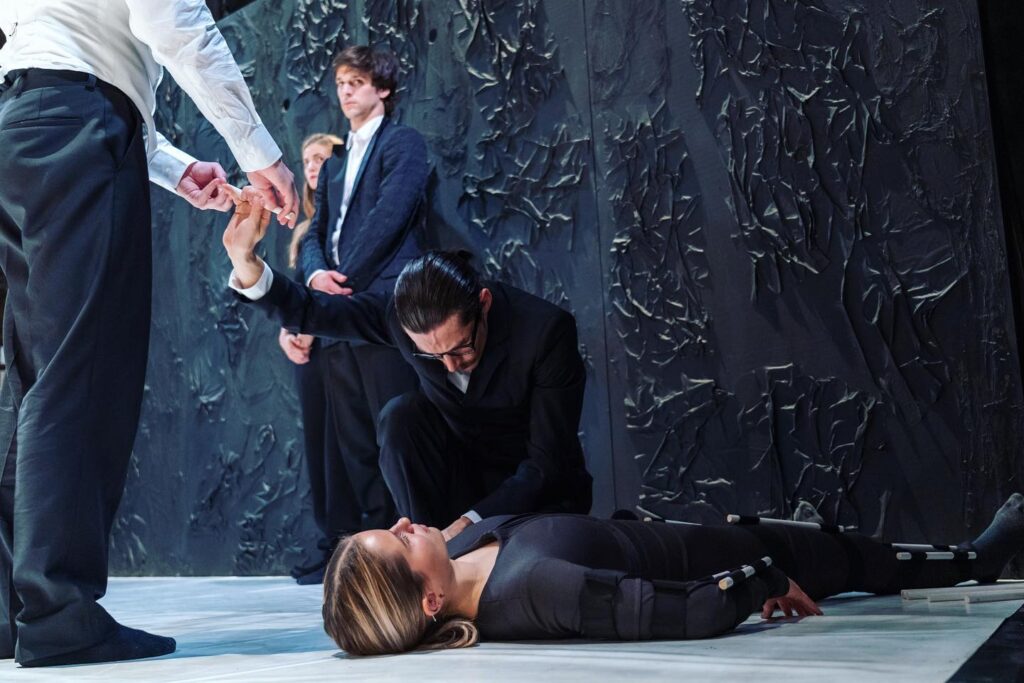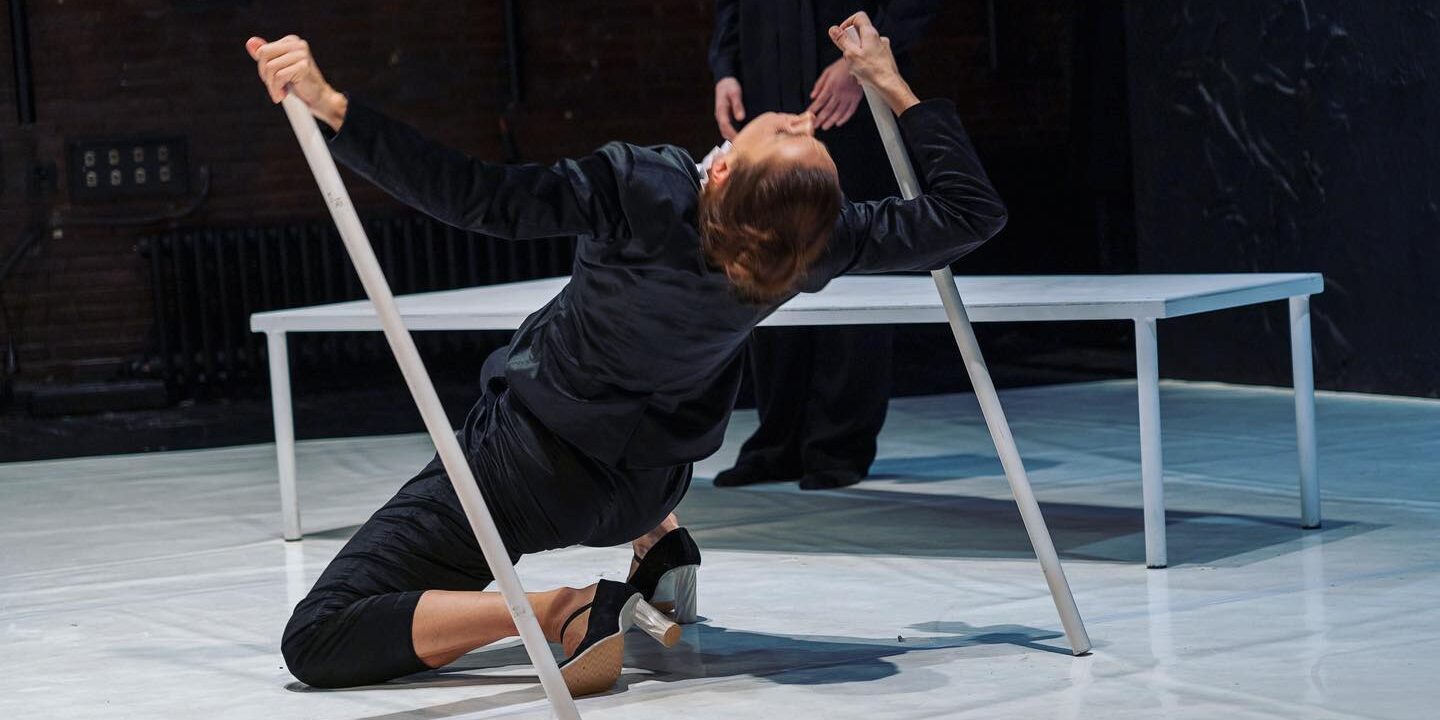BITEF Theatre, Belgrade – BITEF dance company and Felix Landerer, 7th November, 2021
Men in black suits and white collars stand on the stage. Behind them are women in black, almost invisible, their bodies merged with the black background. Between them, there is a desk. A woman in a black suit and a white collar sits on it. She’s the queen. To their left, a tree made of white sticks shines. The men start to pluck the branches from the tree and use them to help the queen to start walking. A clumsy and sterile walking class begins.
‘Sofia’ is a dance performance by BITEF dance company and German choreographer Felix Landerer, It uses dance to analyse a society, its dynamics, its structure and the way knowledge, technology and the gestures of class are used to maintain the power within it.
The style of this performance is minimalistic in every aspect. It invites the viewer to think about everything they see in order to figure out the narrative or create their own. On the denotational level, we are presented with an almost empty stage with white neon sterile lights (sterile is the word which best describes the style of this performance and the world of its narrative). In the background there is a wall covered with relief, almost like the inside of a cave, or stone, or a metaphor for earth, and also Earth, the planet.
On the stage there is one big desk, around which the performers are gathered, one female performer sits at it, eventually it will become a throne. But the most striking part of scenography, by Isidora Spasić, is the tree which is composed of a lot of white sticks. At the beginning, they play the role of branches. It’s the tree of knowledge. The performers take the sticks and use them for different purposes. They use them to write on the wall (they write HELP, and then later change it to HEL when this Game of Thrones reaches its end-point and the new evil queen is crowned).
They make the crown with these sticks; they manipulate the ‘leaders’ with them; they use them as weapons, but most importantly, they use them as a kind of prosthesis for their legs and arms. The figure of the first ‘queen’ is shown learning to walk with crutches, but the second queen is ‘born’ with these prostheses – and she has to learn to move her body with them.
Landerer notes that these prostheses are used in the performance as a symbol of belonging: if it belongs to you, you have power, but if it doesn’t belong to you, you don’t have power. Therefore, the prosthesis is a status symbol, and it becomes an inherent part of the performer’s body and its gestures. It’s very interesting how many meanings are conveyed with this one symbol: it represents knowledge, taken from the tree and then transformed into technology. The performers who wear it as a prosthesis have power, but their walk is artificial, like a tragic version of Monty Python’s Ministry of Silly Walks.
Much of the dance consists of their attempts to learn to walk with them; the way they walk is not just clumsy and stiff, it’s also snobbish, something which is emphasised with their costumes (designed by Selena Orb). The ‘leaders’ wear black suits and white collars, in contrast to those performers who are dressed in black and do not have prosthesis, who are closer to the earth, who dance freely, more naturally, shaking with the wind, but they’re mostly in the background.

Photo credit: Nenad Sugic
The dancing of those in suits, on the other hand, is hard, uncomfortable; they try to walk, they almost fall, they stand on their head, upside-down; the queen dances in high heels while cutting the air with her sword, which also made of a white stick from the tree. They make orders and they take orders; their movements are either fully dominant (the queen) or fully submissive (the servants) – the hierarchy is very clear.
In this world, power is only possible with the use of the prosthesis and it demands giving up freedom and being manipulated; we can also see that the prosthesis is not available to everyone. It is inherited, or has to be earned through cruelty. There is a scene where performers play a game of musical chairs: they walk in circles around the desk, which is also the throne, and the one who sits last, loses the game and doesn’t get a place to sit. The woman born with the prosthesis in her body, is the cruellest to the other woman, the one who loses in this game, and is being promoted to the position of the new queen.
These prostheses are most evidently a symbol of manipulation. Even though the crown is made of the same objects, the other performers use it to manipulate the movements of the queen.
The world of this piece is not a happy one. At the end, almost everybody dies, one by one. The woman who lost the game dies first, after the conflict with the rest, where her dance partner, her lover, tries to protect her. She just falls on the floor like she was shot and continues to lay there until the end. Those on the throne do not blink an eye at this. Her lover dies after her in the same manner. The old queen falls next, and another servant after her. Only the new queen and another servant, live to see the ending. They go into a mini-ecological post-capitalistic action as they put sticks back on the tree of knowledge and watch as images of the performers are projected on the Earth wall. Did they all die for this, to give us, the audience, the knowledge about the HEL they’ve been through, and that we all go through in capitalistic system which is destroying the environment?
Landerer says that this production “raises question about the human mind and its seemingly reduced capacity to recognize that it’s sabotaging its own future”. These words clearly align with the idea that this performance is about a capitalist society which destroys itself. Sofia, is deeply connected with Earth, it is organic, natural and healthy, but this artificial techno-manipulated industrial world of power games is clearly quite opposite.
In the accompanying notes, Landerer also invites us to think about the plight of independent artists who work in the theatre for not much money. Theatre is an industry like any other, so we should also start recognizing the power phenomena within it and try to change these structures, the existence of which we are now very clearly aware, after the Serbian Me Too movement in the acting industry. Environmental destruction, systemic violence, and the patriarchy are all deeply connected. Hopefully, there will be brighter changes in the industry – and in the world – than those depicted in this performance.
Choreography and directing: Felix Landerer
Music: Christoph Littman
Costume: Selena Orb
Stage design: Isidora Spasić
Performers: Ana Ignjatović-Zagorac, Tamara Pjević, Ivana Savić Jaćić, Branko Mitrović, Jakša Filipovac, Nikola Živković, Staša Ivanović
Production: BITEF Teatar and Landerer&Company
Mina Milošević is a playwright, dramaturg, screenwriter, and theoretician based in Belgrade. She holds a BA in Dramaturgy and an MA in Theory of Drama Arts at the Faculty of Dramatic Arts in Belgrade. She worked as a dramaturg on plays in Atelje 212, Belgrade Drama Theatre, Yugoslav Drama Theatre, National Theatre in Belgrade, and Oda Theatre in Prishtina. Her play "Dr Ausländer (Made for Germany)" was presented at BITEF festival 2022. Her master's thesis on female friendship in Serbian contemporary theatre won the "Professor Boško Milin" Award.








